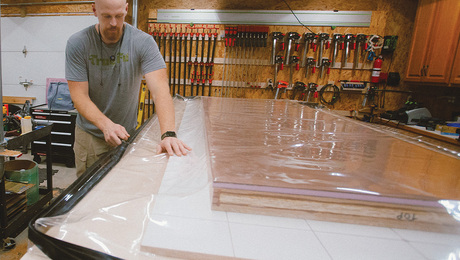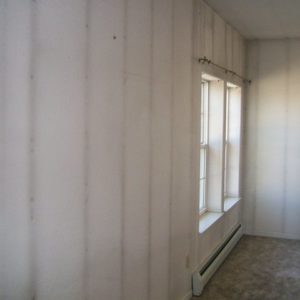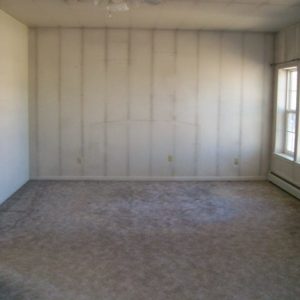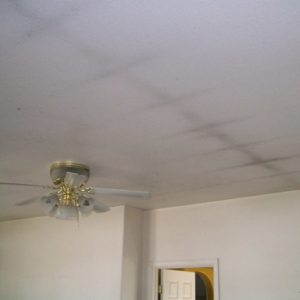I am looking at buying a home in Colorado Springs and from reading the posts on this site I think I have a water transfer “ghosting” problem with the metal studs (photo attached). Can someone tell me if that is what is happening here or if you have seen this before? The home was built in 1994 and has gas hot water heat system. I have another opinion from an electrician friend that thinks there is a ground loop problem? Home is a foreclosure and a great price…unless I have to remove all the walls and ceilings! Is there a way to fix ghosting or whatever this is?
Thanks
Discussion Forum
Discussion Forum
Up Next
Video Shorts
Featured Story

Engineered materials and vacuum-press laminations prevent warping and keep a tall, flush-panel door from being excessively heavy.
Featured Video
Builder’s Advocate: An Interview With ViewrailHighlights
"I have learned so much thanks to the searchable articles on the FHB website. I can confidently say that I expect to be a life-long subscriber." - M.K.
Fine Homebuilding Magazine
- Home Group
- Antique Trader
- Arts & Crafts Homes
- Bank Note Reporter
- Cabin Life
- Cuisine at Home
- Fine Gardening
- Fine Woodworking
- Green Building Advisor
- Garden Gate
- Horticulture
- Keep Craft Alive
- Log Home Living
- Military Trader/Vehicles
- Numismatic News
- Numismaster
- Old Cars Weekly
- Old House Journal
- Period Homes
- Popular Woodworking
- Script
- ShopNotes
- Sports Collectors Digest
- Threads
- Timber Home Living
- Traditional Building
- Woodsmith
- World Coin News
- Writer's Digest





















Replies
"I have another opinion from an electrician friend that thinks there is a ground loop problem? "
What exactly does he mean by "ground loop". I have seen that term misused more than properly used.
And if there was a "ground loop" how would that cause the problem?
And where would enough current come from that would heat all of those studs?
I have never seen such a clear example of ghosting and how uniform it is.
Are you sure that there is an all steel construction? Do you know what the construction is DW through to the siding?
The ceiling pattern looks interesting with it going into 2 directions. If it was steel truss with hat channels then I would expect to see more of a rectangular pattern than the 1 cross strip.
Have you been in the attic?
.
A-holes. Hey every group has to have one. And I have been elected to be the one. I should make that my tagline.
He was not referring to the studs heating up. Just a magnetic field created by the electricity that could be flowing through if a ground loop exists (2 grounds tied at separate locations on the metal "grid" with the grid creating a resistance) or a bare hot wire has contacted the metal frame in the wall. We have not been in the attic. I guess we are not 100% sure it is metal studs that is just what the Realtor said and there is some exposed metal studs in the unfinished basement.
Is this electrical thing feasible. We are told construction is 3/4 sheet rock, metal studs and stucco exteriorEdited 8/7/2008 1:33 pm ET by houseller
Edited 8/7/2008 1:35 pm ET by houseller
"(2 grounds tied at separate locations on the metal "grid" with the grid creating a resistance) "By design a "ground" nomrally does not carry any current. It is only when there is a fault that you have current in the grounds.And while you might have a romex running through a stud and be unprotected and cut into the hot wire. But you would have a large amount of current flowing which should be enough to trip the breaker.But assuming that it was poor connect so say only 10 amps was flowing and assume that did not heat it enough to start a fire then the current quickly get distrubed it. 1/2 would go up the stud and 1/2 down (in a real world it would not be exactly half, but this gives you the idea).Then at the top plate (channel) 1/2 of the 1/2 would go left and 1/2 of 1/2 would go right. Same for the bottom. Then at each connection similar current division would happen. So you would have a hot spot will lesser symptoms as go move a way. Not uniform like this is.So unlessThe ran a unsheilded MRI
There was a supper collider in the room
or It is under a 100kW transmitter antenna and the antenna is pointed down it is not caused by electrical "problems"..
.
A-holes. Hey every group has to have one. And I have been elected to be the one. I should make that my tagline.
Wow, that's easily the worst I've seen. I'm for sure guessing, but the ground loop may have merit, has he encountered a similar symptom and fix? Definately some dust attracting going on there.
Years ago, I had an ion generator that sat on a dresser. Moved the dresser and had a dirt halo around it. No help for you, but I'm interested to see other opinions, maybe this will keep thread alive.
Edit. Not sure how it might be connected, but it appears that the headboard of a bed had similar effect given outline on wall. A
As an exploratory measure, I'd take my point & shoot thermometer on the sunny side of the house and shoot the stud and ajacent wall to determine if there is a temperature differential. Not sure where that would lead but might give a clue to what's happening.
Everything will be okay in the end. If it's not okay, it's not the end.
Edited 8/7/2008 1:23 pm ET by PeterJ
Here is a guess in another direction... and that is that the studs may be transfering tempoerature from outside to insed and when it is cold outside and warm and moist inside, it may draw condensation to the stud locations resulting in mold, staining or dirt accumulation.
I have seen some very interesting things with the transfer of heat and cold on the outsides of homes but this being a foreclosure property, the inside is not heated or vented probably and the inside climate might be right for this kind of reaction.
I refuse to accept that there are limitations to what we can accomplish. Pete Draganic
I don't know anything about the magnetic field theory your electrician friend has, except that if that were true, it seems like you would be seeing the same problem to the same degree everywhere, interior partition wall also.I saw a LOT of the same thing when i lived in Colorado, over on the west slope and higher elevation with wood studs. It is thermal in nature edit - sorry pete, didn't mean to point this at you.
Welcome to the
Taunton University of Knowledge FHB Campus at Breaktime.
where ...
Excellence is its own reward!
Edited 8/7/2008 8:42 pm ET by Piffin
I'm voting for a complete lack of insulation and either a lot of heavy smoking inside or a busy road outside.
Poke a hole in the wall somewhere and see what's in there.
It has insulation I bet. I dealt with one that had missing spots of insulation and those were nearly as dark as the studs, the thermal bridge is what does it. Cold spots on studs attracts condensation which causes growth of mildew feeding on the dust that sticks to the damp. Soot too when it exists.
Welcome to the Taunton University of Knowledge FHB Campus at Breaktime. where ... Excellence is its own reward!
This is an extreme example of the classical case where someone smokes or burns a lot of smokey candles in a house. In the winter the exterior walls are cooler in the areas directly over the studs (since the studs insulate less well than regular insulation) and this causes soot in the air to settle on the walls in those spots.
The problem can be exacerbated by excessive humidity levels in the house, leading to condensation over the studs.
The walls will need to be wiped down with a TSP solution, then primed with a stain-blocking primer. If humidity levels turn out to be high in the house (in winter) a heat recovery ventillator should be installed.
Another potential source of soot (besides cigarettes and candles) is a poorly-burning wood fireplace.
It is an ironic habit of human beings to run faster when we have lost our way. --Rollo May
No fireplace in the home, so If we wipe down, prime and paint will we just have too keep doing that every few years? Is the moisture/vapor enough to cause the evil black mold? or some less evil mildew? Would gas hot water boiler heat system cause excess humidity? Would you guys run away from buying a home that looks like this? It's 4200sf @ $230K appraised in 2004 @ $350K
Edited 8/7/2008 3:29 pm ET by houseller
Remove the source of soot (and control winter humidity) and you'll have no more ghosting. I doubt that there's any mold present but to be sure you can blot an affected area with fresh bleach. Mold will almost instantly disappear, but soot will barely be affected (though the paint behind it may turn paler).A hot water system doesn't introduce moisture into the house unless it's seriously malfunctuning.(Note that it's probably worthwhile to spend a few bucks on an inspection before dropping $230K on this house.)
It is an ironic habit of human beings to run faster when we have lost our way. --Rollo May
At this price unless you don't plan to make it your own. I'd consider opening up a few walls and try to determine whats happening inside the stud bays. I've never seen anything like that before. Interested in finding out what si causing this.ML
i've seen a lot of it. I know exactly what you'd see in the walls
Welcome to the Taunton University of Knowledge FHB Campus at Breaktime. where ... Excellence is its own reward!
Interesting one.
I am guessing either Mold or Soot. Read a lot of responses as well.
The soot will be on the surface. The mold might migrate thru some.
Both will smear so it might be hard to distinguish between the two.
Uniform mold growth from high to low is not typical because of varying temperatures in a room from ceiling to floor and varying relative humidity. (but i recon it is possible)
If soot, it is likely negative pressure in lower level from propane burner and no makeup air. (at least that is what I learned)
If you give the lower level make up air, sooting should stop.
We always got it along the edge of the carpets but had forced air systems and return air thru the walls which would suck the soot thru the gap between the drywall and the floor.
Put in air exchanger or cut a big hole in the exterior wall (we re-sealed the return air trunks and put a 6" fresh air supply in the return plenum and the house still sooted, We enlarged it to 8" and it stopped sooting.
This was a long time ago when gas was around $1.59 per gallon and fresh air exchangers were just starting to be heard of so an 8" hole was a good solution......
HMMM I am wondering!!!
Anyway, that is the past.
"will we just have too keep doing that every few years?"That depends on a lot of variables. If you burn a lot of candles and use a humidifieer set too high, yes. Another way to stop it is to buffer that thermal bridge by removing the sheetrock, installing 3/4" or 1" Thermax, then new interior finish."Would gas hot water boiler heat system cause excess humidity?"Only if it is not properly vented to exhaust.
Welcome to the Taunton University of Knowledge FHB Campus at Breaktime. where ... Excellence is its own reward!
We might as well rebuild if that is the way to really fix this. The same ghosting is on all the exterior walls (not as bad as this master bedroom)
throughout the 4200sf house. Is it possible to spray something on the outside of the EIFS to "seal" it?
sealing it is not the concern.Isolating the cold steel studs from the warm moist ( and possibly sooty) interior air is the need.There could well be two different problems here.One is as I mention.The other is that this is inappropriate design/materials choice for the climate.
That latter would concern me more, and like you say, it would take a heck of a 'value' pricing before I would be willing to take a chance on it. The thing about older EIFS systems is that they were too often not properly detailed, and many hundreds ( thousands more likely) have been given new exterior treatments and mold remediation at great cost.If I were your insurance agent, the signs you see there would make me run for the exit like the place was on fire. I don't know how they would write a policy on a house exhibiting signs of potential mold infestation like that.
Welcome to the Taunton University of Knowledge FHB Campus at Breaktime. where ... Excellence is its own reward!
We know that the previous residents didn't pay the mortgage. How long did they live there after the didn't pay the utilities and they were shut off so they used candles, lanterns, and kerosene heaters? All that soot with bad thermal bridging could be the problem.
Plus it's Colorado and you know the illegal substances they like to smoke out there....
Bill's right, the ghosting you see here has nothing to do with ground loops or anything electrical. Ground loops are a serious problem in high gain analog amplifiers, but we have them all over the place in buildings everywhere, with no detectable effects.
This looks like massive thermal bridging. Could the dark material possibly be the trendily dreaded mold? ;-)
-- J.S.
I'll bet a dollar that there is no thermal break on the studs. They will conduct heat out of the house forever without some sort of remedy. This could be expensive.
thermal break? Are you saying that there needs to be some type of insulation between the stud and the sheet rock?
Or on the outside of the studs.That is why I asked you if you exactly how the wall was constructed from the DW to the outside siding.One option would hve been to use insulated sheeathing or foam sheets over the sheating before the siding goes on..
.
A-holes. Hey every group has to have one. And I have been elected to be the one. I should make that my tagline.
Stucco exterior? As in EIFS? House built in 1994?
Hmmmmm......
Heres some exteriors, not sure what EIFS is and yes 1994... This is why I was a little confused I thought this type of exterior finish was laid over a foam type product that should be an insulator.
Heres a question/idea you can see a discoloration on the exterior finish...is it possible my "stucco" is leaking?
FWIW this is what I'd do.... and remember this advice is free so you got what you paid for.
If the house is a deal and under forclosuer I'd put in a contract with the stipulation of cancellation based on an EIFS inspection. If it's normal ghosting clean paint and move on. If the EIFS is screwed the seller now has a big problem on their hands which will enhance your position if you really want the house.
Remember this isn't a homeowner selling a house, you are dealing with a desk jockey who's job description says get rid of this property... they are typically poor negotiators.
If that is EIFS, that should be providing plenty of thermal break on the outside. You need an inspector to assess how the 'stucco' was done , if it includes foam, and whether it is flashed right or leaking.I don't believe there was foam under that. The foam would prevent the thermal bridging.
Welcome to the Taunton University of Knowledge FHB Campus at Breaktime. where ... Excellence is its own reward!
I went to a greenbuilding conference a few months ago where one of the sessions was by some "building forensics" experts. That is, they go into buildings that have failed and determine why. I saw some photos they had of a failed building that were very similar to these photos, though not quite as graphic nor as widespread. Thermal bridging WAS the cause of the failure they were demonstrating in this particular building with metal framing. Moisture had condensed on the inside of the wall (and in the interior of the wall where it wasn't readily detectable), causing massive mold growth. Though the wall appeared to be insulated, there was one area that wasn't insulated (visible from the attic, once a wall section was removed) and it was sucking all the heat from that one area, pulling it from the rest of the framing members, causing condensation.I can't say whether this is your problem or not. Since the problem looks so vast (at least in these photos), if it were thermal bridging, you would expect the utility bills to be high--can you ask for copies of past years' bills?--L.
To my eyes, the stucco on the gable end of the garage looks wet, except for a lighter dry band at the top. Perhaps another symptom of way too much water or water vapor?
-- J.S.
It would be interesting to know some more history.First from the landscaping I would have though that it was finished last years, not 14 years ago.And I wonder how long the last people where it and if they might have used a kerosen heater or not for a long period of time.I most areas you can get the transactions on the property recorded at the "deed office". Interesting to see how long the last people where there and if they had a number of liens and/or refi's.You might also want to ask the neighbors if they know anything about the house and ghosting.And if you get serious you might want to find a home inspector or energy rater that can do an infrared camera inspection. That will help tell you how bad the bridging is if that is the problem and also can detect moisture spots..
.
A-holes. Hey every group has to have one. And I have been elected to be the one. I should make that my tagline.
Insulate between the stud and the sheetrock or between the stud and the exterior sheeting. Either one will work. The "ghosting" you see is common here in my cold climate with wood 2x4 studs that used to be common. It's less with 2x6 studs... more wood/more insulation. A steel stud will conduct heat like nobody's business. This causes the problem you see. It will also make for a very uncomfortable home not to mention expensive to heat. If they cut corners there, who know what else is wrong with the thermal envelope? You need to get a very through inspection of this house by a qualified home inspector or engineer. Otherwise, there's probably less risk to your money in Las Vegas.
I'm betting on thermal bridging as well as poor humidity control (or poor air circulation).
On the bright side, finding studs for hanging pictures will be easy. - lol
Sure that's not striped wallpaper?